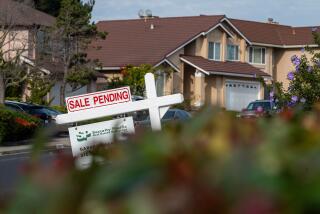Drop in Home Building Seen : Higher Interest Rates Will Make it Tougher for Buyers
Housing construction is expected to decline about 5% this year and sales will drop about 4% as the nation’s housing market cools down from a feverish 1988 and higher interest rates make it even tougher for Americans to buy a home.
Nationwide, home prices are expected to rise about 5 1/2%--roughly in line with the overall inflation rate. But continued strong demand and a shortage of homes for sale should push the price of a typical California home up a heftier 8%, with even larger increases predicted for most parts of the Southland.
“Things are going to slow down in 1989, but it will still be a pretty good year for housing,” says John Tuccillo, chief economist of the National Assn. of Realtors.
Weakness in Northeast
“There will be no crash in the nation’s housing market.”
Still, some parts of the country will feel the slowdown more than others.
Construction and sales alike are expected to continue dropping in the Northeast, a region that is still trembling from the stock market crash of October, 1987. The region was the nation’s hottest housing market through much of this decade, but overbuilding and the loss of 20,000 financial-services jobs in the wake of the crash have left sellers outnumbering buyers.
The outlook is much brighter in the Midwest, thanks to a resurgence of the manufacturing sector and a firming agriculture business.
“The Midwest missed out on a lot of this decade’s housing boom,” says Tuccillo. “But now its economy is picking up, and that is helping its housing market.”
Sales and construction in the South are expected to remain relatively sluggish as the region’s economy continues to suffer from the depressed energy business.
But California’s housing market is expected to remain strong, thanks to the state’s vibrant economy, a near-record low inventory of homes for sale and a scarcity of buildable land in many parts of the state.
About 513,800 existing California homes are expected to be sold this year, down 7% from 1988, predicts the California Assn. of Realtors. But last year’s sales pace was the best in the decade, notes CAR chief economist Joel Singer, so “even with a 7% drop in sales, we’re looking at a very good year.”
Double-Digit Price Gains
Statewide, the price of a typical California home will rise about 8.2%, to $177,500 this year, Singer predicts.
Singer says Southland prices will probably rise even faster than the statewide average, with Los Angeles, Orange and San Diego counties all logging double-digit price gains.
About 216,000 new houses, condominiums and apartments will be built in California this year, 13% below the number of new homes built in 1988, according to the Burbank-based Construction Industry Research Board.
However, the expected decline in California’s construction rate won’t trigger a wave of layoffs in the building industry.
More Construction Jobs
“A lot of builders got their (construction) permits last year, but their projects haven’t gotten started yet,” says Ben Bartolotto, the board’s research director.
“In fact, we’ll probably see the number of construction jobs go up a bit this year after these projects get under way.”
Other housing-related developments to watch for in 1989:
Introduction of a far-reaching federal housing bill.
U.S. Sens. Alan Cranston (D-Calif.) and Alfonse D’Amato (R-N.Y.) are expected to introduce their proposed “National Affordable Housing Act” in the 101st Congress, which opened last Tuesday.
Tax-Deferred Savings Account
Among other items, a draft of the bill calls for making low down-payment Federal Housing Administration loans available to more buyers in high-cost housing states, such as California, New York and Massachusetts.
The legislation would also allow would-be buyers to put a portion of their earnings into a tax-deferred savings account that could eventually be tapped for a down-payment on a house. People who already have an Individual Retirement Account could draw their money out without penalty if the cash would be used to buy a home.
More private-sector help for the homeless and low-income people.
U.S. Rep. Jack Kemp (R-N.Y.), who’ll head the federal Department of Housing and Urban Development in the Bush Administration, is expected to push for tax breaks and other incentives to get private-sector builders more involved in moderate-income housing and inner-city redevelopment.
Kemp is also expected to push for expansion of the controversial “voucher” program--in which poor people seek out apartments owned by private-sector landlords and then use a government voucher to pay for part of their rent--and for programs that let tenants in public-housing projects buy their rental units.
Model for Other Cities
More cooperation between builders and slow-growth advocates.
After bitter battles, about half of the slow-growth measures on local ballots last November were approved, and several others lost by thin margins.
Some observers say an agreement hammered out between developers and environmentalists in San Bernardino last month could be used as a model for other cities. The pact calls for growth to be channeled into already urbanized areas and for builders to pay for new roads, sewers and other facilities needed by new residents.
“We’re willing to trade some possible speculative profits for a certain amount of stability,” San Bernardino builder representative Joseph DiIorio told The Times last month. “Also, we’re kind of tired of being called the bad guys and we’d like to leave something behind in the way of careful planning.”
More to Read
Inside the business of entertainment
The Wide Shot brings you news, analysis and insights on everything from streaming wars to production — and what it all means for the future.
You may occasionally receive promotional content from the Los Angeles Times.










